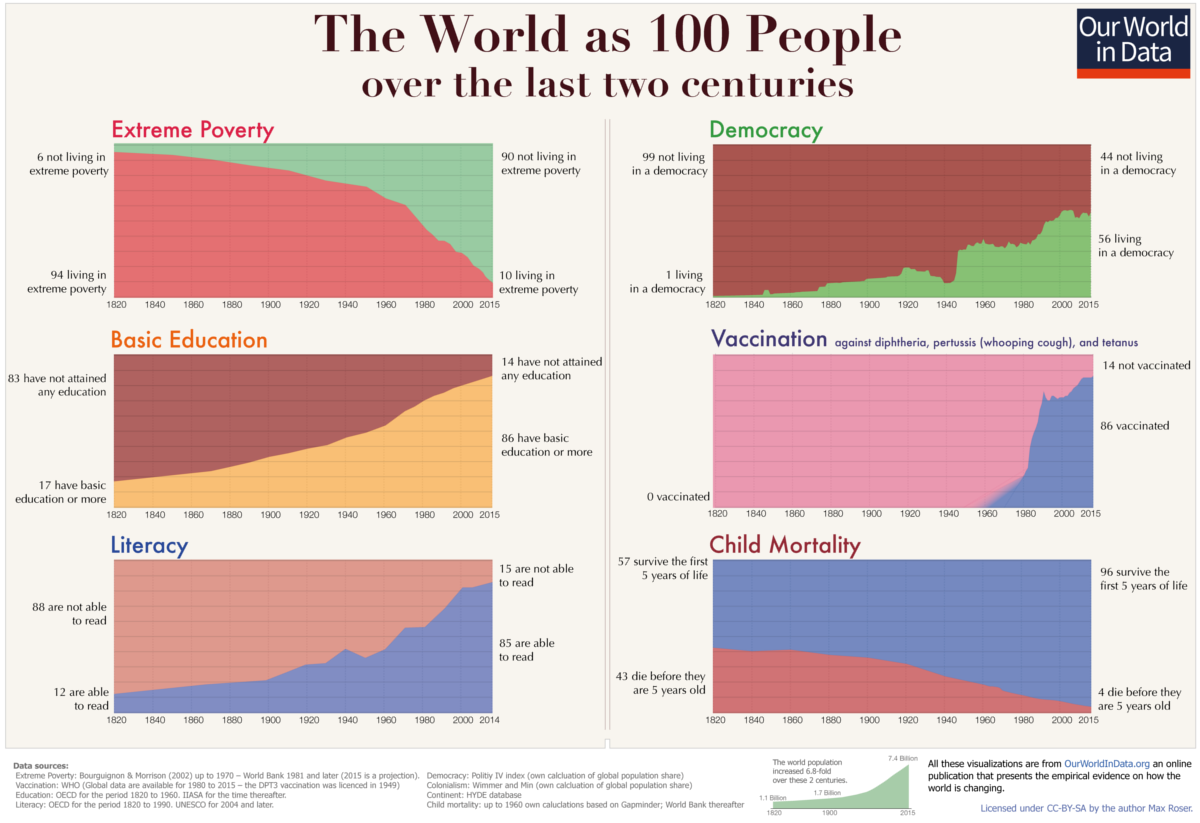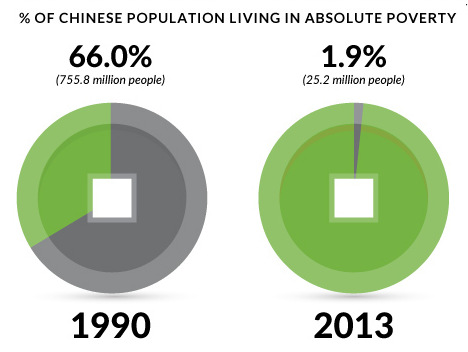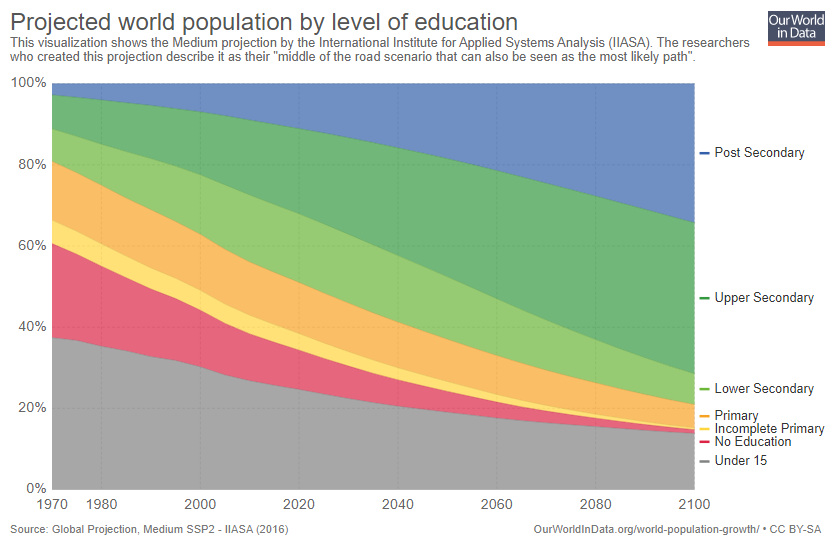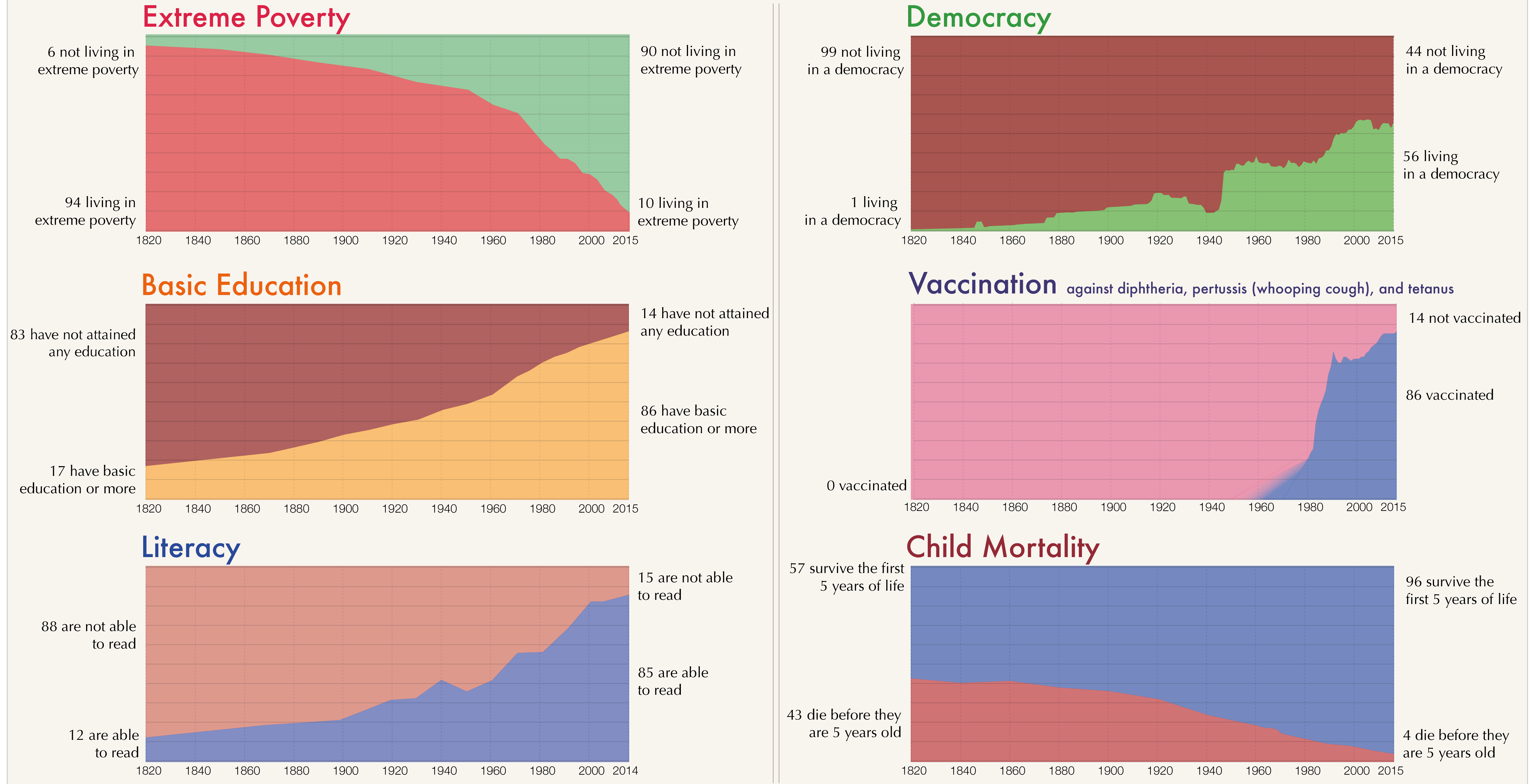Technology
These 6 Charts Show How the World is Improving
View a high resolution version of this graphic

These 6 Charts Show How the World is Improving
View the high resolution version of today’s graphic by clicking here.
It only takes a few minutes of cable news to get the feeling that the world is heading into a tailspin.
Endless images of homicide investigations, natural disasters, car crashes, and drug busts fill the airwaves on a daily basis. It’s upsetting – but also certainly captivating for the average viewer.
In fact, the news cycle thrives on fear and violence, so mainstream networks find a way to fill up 99% of programming with these singular events. It’s addicting and sometimes anger-inducing, but is it representative of what’s really going on in the world?
Good News Happens Slowly
Today’s infographic comes to us from economist Max Roser of Our World in Data, and it highlights six megatrends that show that in many important ways, our world is improving drastically.
The one commonality of these six indicators? They all happen slowly and incrementally, but are more evident with a long-term perspective.
Each family lifted out of poverty, each classroom that gets built, and each village gaining access to basic vaccinations may not seem significant on a scale of billions of people – but over decades, these gains add up to create a richer, more educated, and healthier world and a very powerful statistical story.
Six Global Trends
Here are the six big picture trends pointed out by Roser, using data collected over hundreds of years:
1. Extreme Poverty
The portion of people in extreme poverty – making less than $1.90 per day – has dropped like a rock over the years. Back in 1940, about 75% of the world was in extreme poverty – today, that number is just 10%.
The most potent recent example of this is China, where access to free markets have enabled 700 million people to be lifted out of poverty in just over 20 years.

It’s also worth mentioning that statistics for this category are done using inflation-adjusted international dollars, which take into account inflation over time as well as exchange rates. Non-monetary forms of income are also included in the calculations.
2. Basic Education
In 1820, only a privileged few were able to get basic schooling. Since then, millions of classrooms and schools have been added around the globe, and the numbers are staggering. In relative terms, we’ve gone from 17% of people having a basic education to 86% today.
Here’s a more detailed breakdown of this, also from Our World in Data:

3. Literacy
Following a similar trend line as basic education, literacy has risen from 12% to 85% over roughly two hundred years. In absolute terms, these numbers are even more impressive. In the 1820s, there were only about 100 million people that could read that were 15 years or older. Today, the number stands at 4.6 billion.
4. Democracy
While the world has been having some short-term setbacks when it comes to freedom and democracy, the overall trend line is still impressive over the long run.
In 1900, only 1 in 100 people worldwide lived in a democracy – and today, the majority (56 in 100) can say they live in a country with free and fair elections.
5. Vaccination
Vaccinations for diseases like whopping cough, tetanus, and diphtheria were unavailable for most of the 200 year chart. However, today around 86% of people globally are vaccinated against these basic and devastating illnesses.
6. Child Mortality
Even as far back as 1920, it used to be that over 30% of infants would die before they hit their 5th birthday.
Since then, developments in housing, sanitation, science, and medicine have made it so that death is a much rarer occurrence for the youngest people in our society. Today, on a global basis, child mortality has been reduced to 4%.
Technology
All of the Grants Given by the U.S. CHIPS Act
Intel, TSMC, and more have received billions in subsidies from the U.S. CHIPS Act in 2024.

All of the Grants Given by the U.S. CHIPS Act
This was originally posted on our Voronoi app. Download the app for free on iOS or Android and discover incredible data-driven charts from a variety of trusted sources.
This visualization shows which companies are receiving grants from the U.S. CHIPS Act, as of April 25, 2024. The CHIPS Act is a federal statute signed into law by President Joe Biden that authorizes $280 billion in new funding to boost domestic research and manufacturing of semiconductors.
The grant amounts visualized in this graphic are intended to accelerate the production of semiconductor fabrication plants (fabs) across the United States.
Data and Company Highlights
The figures we used to create this graphic were collected from a variety of public news sources. The Semiconductor Industry Association (SIA) also maintains a tracker for CHIPS Act recipients, though at the time of writing it does not have the latest details for Micron.
| Company | Federal Grant Amount | Anticipated Investment From Company |
|---|---|---|
| 🇺🇸 Intel | $8,500,000,000 | $100,000,000,000 |
| 🇹🇼 TSMC | $6,600,000,000 | $65,000,000,000 |
| 🇰🇷 Samsung | $6,400,000,000 | $45,000,000,000 |
| 🇺🇸 Micron | $6,100,000,000 | $50,000,000,000 |
| 🇺🇸 GlobalFoundries | $1,500,000,000 | $12,000,000,000 |
| 🇺🇸 Microchip | $162,000,000 | N/A |
| 🇬🇧 BAE Systems | $35,000,000 | N/A |
BAE Systems was not included in the graphic due to size limitations
Intel’s Massive Plans
Intel is receiving the largest share of the pie, with $8.5 billion in grants (plus an additional $11 billion in government loans). This grant accounts for 22% of the CHIPS Act’s total subsidies for chip production.
From Intel’s side, the company is expected to invest $100 billion to construct new fabs in Arizona and Ohio, while modernizing and/or expanding existing fabs in Oregon and New Mexico. Intel could also claim another $25 billion in credits through the U.S. Treasury Department’s Investment Tax Credit.
TSMC Expands its U.S. Presence
TSMC, the world’s largest semiconductor foundry company, is receiving a hefty $6.6 billion to construct a new chip plant with three fabs in Arizona. The Taiwanese chipmaker is expected to invest $65 billion into the project.
The plant’s first fab will be up and running in the first half of 2025, leveraging 4 nm (nanometer) technology. According to TrendForce, the other fabs will produce chips on more advanced 3 nm and 2 nm processes.
The Latest Grant Goes to Micron
Micron, the only U.S.-based manufacturer of memory chips, is set to receive $6.1 billion in grants to support its plans of investing $50 billion through 2030. This investment will be used to construct new fabs in Idaho and New York.
-

 Debt1 week ago
Debt1 week agoHow Debt-to-GDP Ratios Have Changed Since 2000
-

 Markets2 weeks ago
Markets2 weeks agoRanked: The World’s Top Flight Routes, by Revenue
-

 Demographics2 weeks ago
Demographics2 weeks agoPopulation Projections: The World’s 6 Largest Countries in 2075
-

 Markets2 weeks ago
Markets2 weeks agoThe Top 10 States by Real GDP Growth in 2023
-

 Demographics2 weeks ago
Demographics2 weeks agoThe Smallest Gender Wage Gaps in OECD Countries
-

 Economy2 weeks ago
Economy2 weeks agoWhere U.S. Inflation Hit the Hardest in March 2024
-

 Green2 weeks ago
Green2 weeks agoTop Countries By Forest Growth Since 2001
-

 United States2 weeks ago
United States2 weeks agoRanked: The Largest U.S. Corporations by Number of Employees













